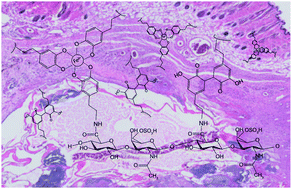A DOPA-functionalized chondroitin sulfate-based adhesive hydrogel as a promising multi-functional bioadhesive†
Abstract
Great progress has been achieved on the study of hydrogels, which were presented for the first time in 1960 by Otto Wichterle and Drahoslav Lím. The two crucial properties of hydrogels, namely high water content and biocompatibility, have made hydrogels ideal compositions in the development of bioadhesives in recent years. Chondroitin sulfate (CS), a sulfated glycosaminoglycan (GAG), is distributed throughout animal bodies, including cartilage and the extracellular matrix (ECM), and it has been widely utilized in the dietary supplement and pharmaceutical industries. Besides, CS has been reported to have excellent pain-relief and anti-inflammation properties. Some studies have even reported CS's wound healing promoting ability. In this study, taking advantage of CS's excellent physical and chemical properties, DOPA groups were functionalized onto CS backbones. After that, the potential of the newly established CS-DOPA (CSD) hydrogel to work as a bioadhesive in multiple internal medical conditions was evaluated through in vitro and in vivo means. The outcomes of the in vivo assessments demonstrated CSD's promising potential to be further commercialized into an adhesive hydrogel product, and to be utilized in diverse clinical medications in the future.

- This article is part of the themed collection: Hydrogel properties and applications


 Please wait while we load your content...
Please wait while we load your content...